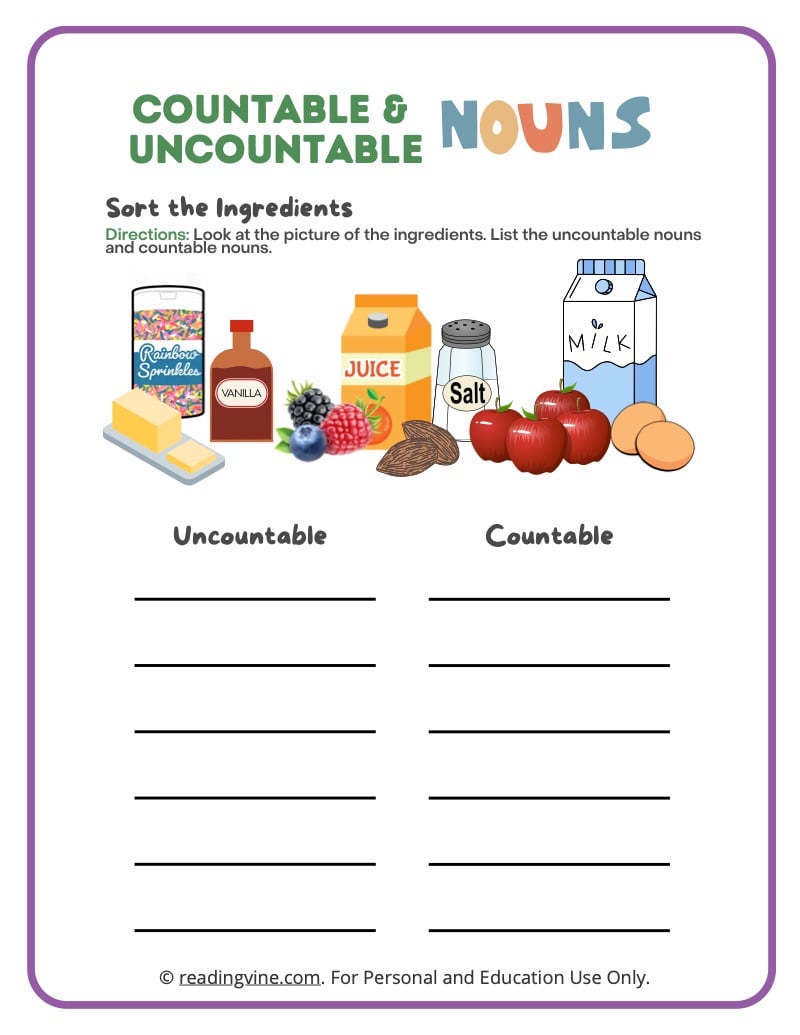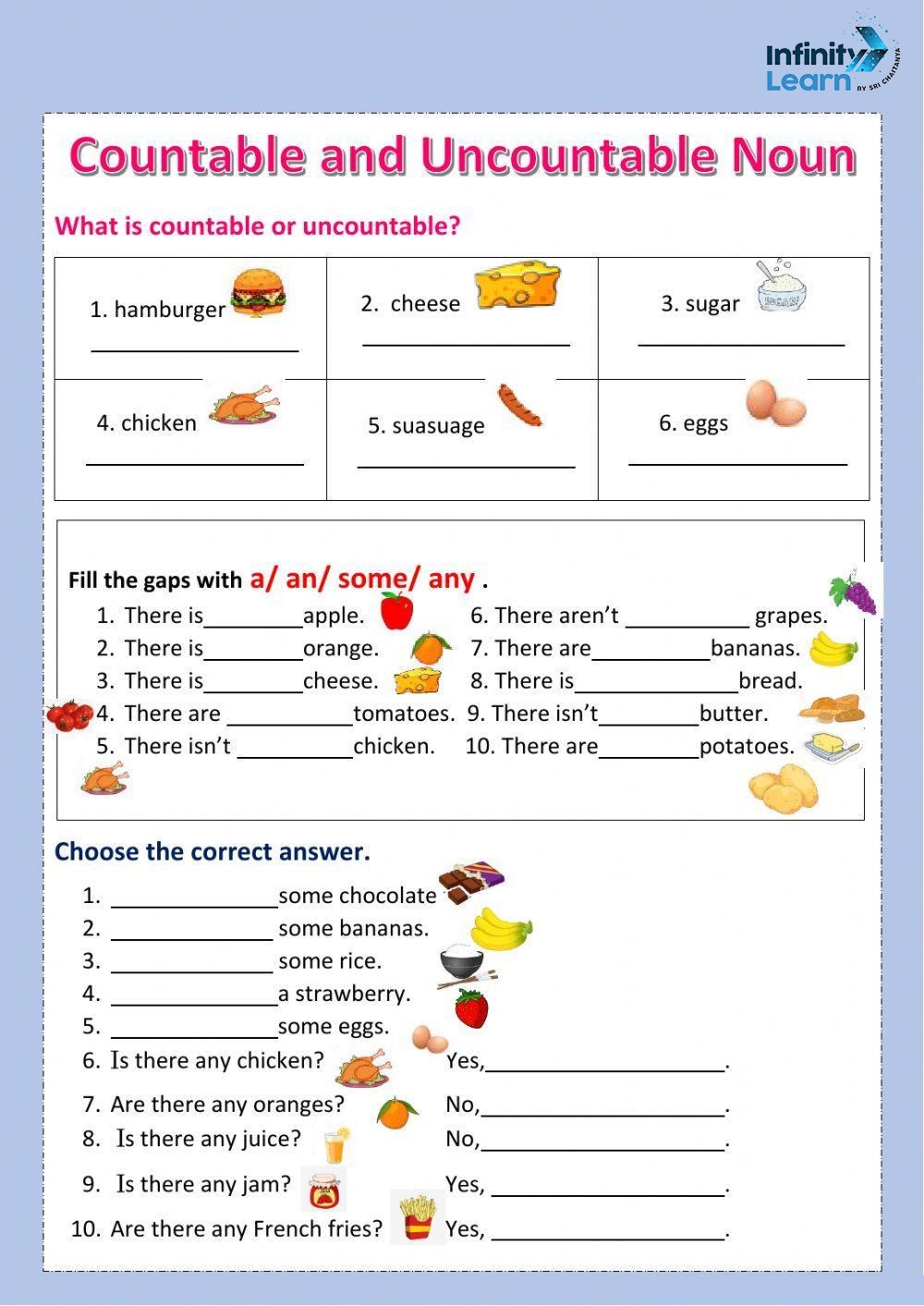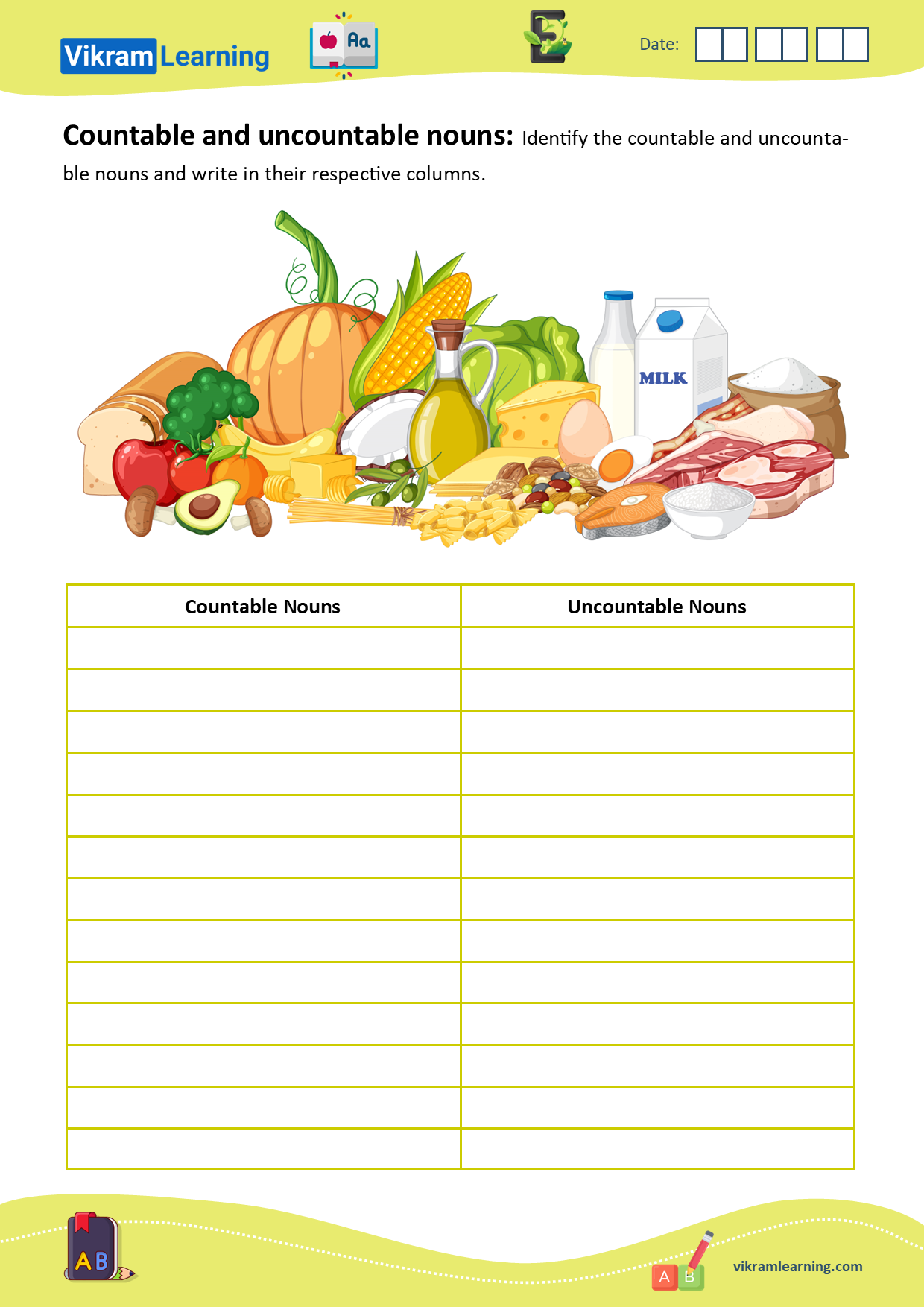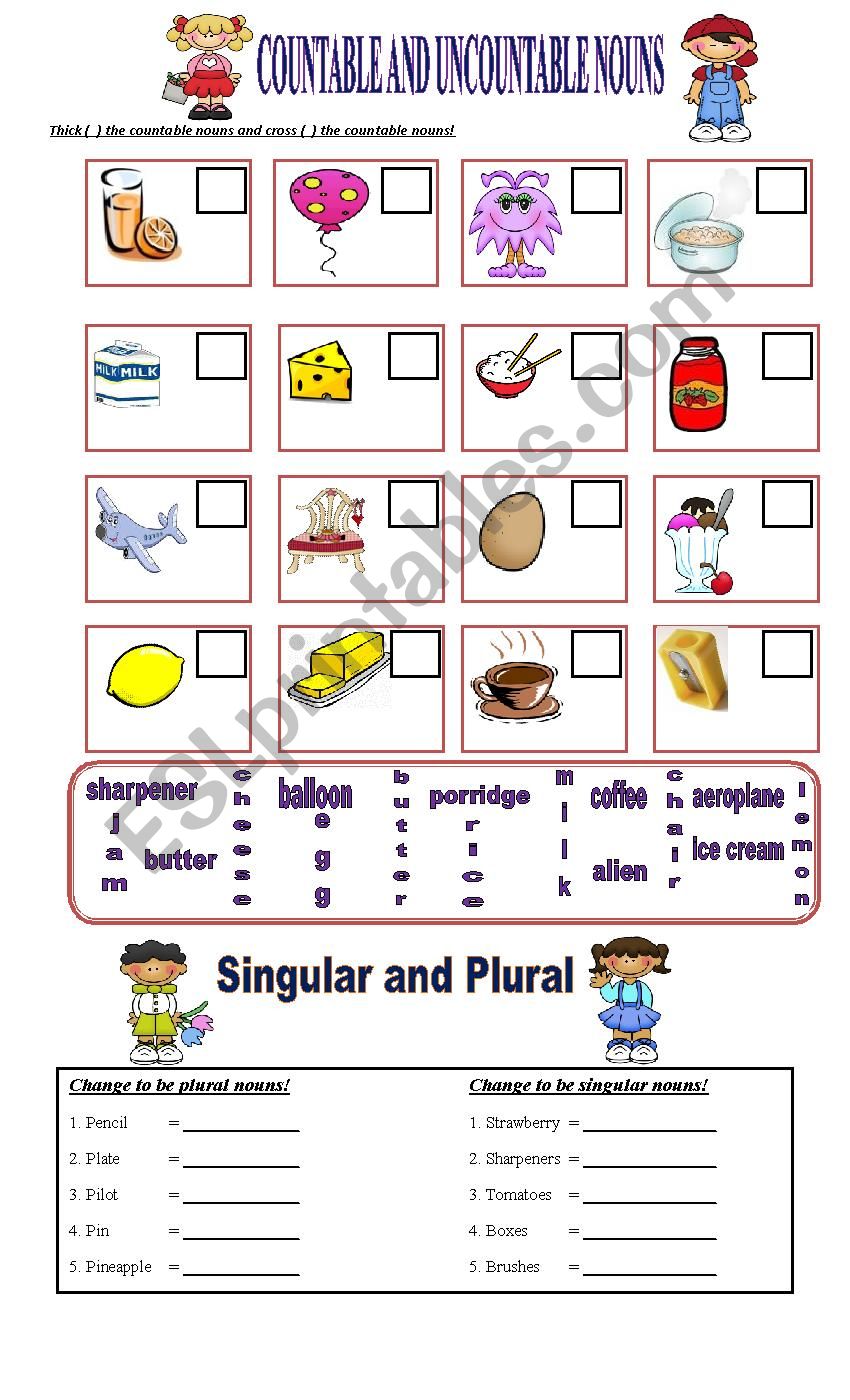
Mastering the Building Blocks: The Indispensable Role of Noun Worksheets (Countable, Uncountable, Plural)
In the vast and intricate landscape of the English language, nouns stand as fundamental pillars, forming the very bedrock of sentences and communication. Without a solid grasp of nouns, their forms, and their functions, learners often find themselves adrift, struggling to construct grammatically correct and coherent expressions. Among the most critical distinctions concerning nouns are their classifications as countable or uncountable, and the rules governing their singular and plural forms. This is precisely where noun worksheets (countable, uncountable, plural) become an invaluable pedagogical tool, offering structured practice that transforms abstract grammatical rules into concrete, applicable knowledge.
The journey to mastering English nouns is often fraught with challenges. Unlike some other languages, English boasts a complex array of pluralization rules, including numerous irregular forms, and a nuanced system for distinguishing between items that can be counted individually and those that cannot. For non-native speakers, these distinctions can be particularly perplexing, leading to common errors such as "much books" instead of "many books," or "informations" instead of "information." This article will delve into the critical importance of noun worksheets (countable, uncountable, plural), exploring their benefits, the types of exercises they should encompass, and how they empower learners to navigate the complexities of English noun usage with confidence.
The Intricacies of English Nouns: Why Practice is Paramount

Before dissecting the utility of worksheets, it’s essential to understand the inherent complexities that make dedicated practice indispensable:

-

Countable Nouns: These are nouns that can be counted individually. They have both singular and plural forms (e.g., a book, two books; an apple, three apples). They can be used with numbers and quantifiers like "many," "few," "a few," "several," etc. The challenge often lies in correctly forming their plurals, especially irregular ones.

-
Uncountable Nouns: Also known as mass nouns, these refer to things that cannot be counted individually. They typically do not have a plural form and are always treated as singular (e.g., water, information, advice, furniture, happiness). They are used with quantifiers like "much," "little," "a little," and often require "units of measurement" to quantify them (e.g., a glass of water, a piece of advice). Distinguishing them from countable nouns can be tricky, as some nouns can be both depending on context (e.g., light as in illumination vs. a light as in a lamp).
-

Plural Nouns: While intrinsically linked to countable nouns, the formation of plurals itself presents a significant hurdle. English pluralization rules are notoriously inconsistent:
- Regular Plurals: Adding ‘-s’ or ‘-es’ (e.g., cat-cats, box-boxes).
- Irregular Plurals: These defy standard rules and must be memorized (e.g., man-men, child-children, mouse-mice, tooth-teeth, sheep-sheep).
- Nouns ending in -y: Changing ‘y’ to ‘i’ and adding ‘-es’ (e.g., baby-babies).
- Nouns ending in -f or -fe: Changing to ‘-ves’ (e.g., leaf-leaves, knife-knives).
- Nouns borrowed from other languages: Often retaining their original plural forms (e.g., cactus-cacti, phenomenon-phenomena).
- Nouns that are always plural: (e.g., scissors, pants, glasses).
- Nouns that are always singular: (e.g., news, mathematics).




Given this labyrinth of rules and exceptions, rote memorization alone is insufficient. Learners need repeated, varied, and contextualized exposure to internalize these concepts, and this is where the power of noun worksheets (countable, uncountable, plural) truly shines.
The Multifaceted Benefits of Noun Worksheets
Well-designed noun worksheets (countable, uncountable, plural) offer a plethora of advantages for both learners and educators:
- Reinforcement and Consolidation: Worksheets provide the necessary repetition to solidify grammatical rules learned in class. They transform passive knowledge into active application, ensuring that concepts move from short-term to long-term memory.
- Targeted Practice: Unlike general grammar exercises, dedicated noun worksheets allow learners to focus specifically on countable, uncountable, and plural forms. This targeted approach helps address specific areas of weakness without overwhelming the learner.
- Variety of Exercise Types: Effective worksheets don’t just ask learners to identify nouns. They incorporate diverse exercise formats such as:
- Categorization: Sorting lists of nouns into "countable" and "uncountable."
- Pluralization Practice: Writing the correct plural form of given nouns (including regular and irregular).
- Fill-in-the-Blanks: Choosing the correct quantifier (much/many, little/few) or noun form to complete sentences.
- Error Correction: Identifying and correcting noun-related errors in sentences.
- Sentence Construction: Using specific countable or uncountable nouns correctly in original sentences.
- Matching Exercises: Pairing singular nouns with their correct plural forms.
- Self-Assessment and Immediate Feedback: Many worksheets come with answer keys, allowing learners to check their work immediately. This instant feedback loop is crucial for self-correction and understanding mistakes, fostering independent learning.
- Differentiation: Worksheets can be tailored to different proficiency levels. Beginners might start with simple identification and regular pluralization, while advanced learners can tackle more complex irregular forms, context-dependent usage, and nuanced quantifier distinctions.
- Engagement and Motivation: When designed creatively, using engaging themes, illustrations, or real-world scenarios, worksheets can make learning grammar less daunting and more enjoyable. They can transform a potentially dry topic into an interactive activity.
- Assessment Tool for Educators: For teachers, worksheets serve as an excellent diagnostic tool, revealing common errors and areas where further instruction or remediation is needed. They provide tangible evidence of a student’s understanding and progress.
Components of Highly Effective Noun Worksheets (Countable, Uncountable, Plural)
To maximize their effectiveness, noun worksheets (countable, uncountable, plural) should incorporate several key elements:
- Clear and Concise Instructions: Ambiguous instructions can hinder learning. Worksheets should clearly state what is expected of the learner.
- Gradual Increase in Difficulty: Start with simpler concepts (e.g., identifying countable/uncountable, regular plurals) and progressively introduce more complex rules (e.g., irregular plurals, nuanced quantifier usage, context-dependent nouns).
- Contextualized Sentences: Isolated words are less effective than words used in meaningful sentences. Context helps learners understand the natural usage of nouns and their forms. For example, instead of just "Write the plural of ‘fish’," use "There was one fish in the bowl, but now there are many fish."
- Sufficient Practice Items: There should be enough exercises to allow for ample practice without being overly repetitive or tedious.
- Inclusion of Common Irregularities: Since irregular plurals and context-dependent countable/uncountable nouns are common pitfalls, worksheets must specifically address these.
- Visual Aids: For younger learners or visual learners, incorporating relevant images can enhance comprehension and make the exercises more appealing.
- Answer Key: As mentioned, an answer key is vital for self-correction and independent learning.
Integrating the Concepts: Practical Worksheet Examples
Let’s look at how noun worksheets (countable, uncountable, plural) can integrate these concepts effectively:
-
Mixed Identification and Categorization: A worksheet could present a list of 20 nouns. Learners would first identify each as countable or uncountable. Then, for the countable nouns, they would write their plural forms. For example:
- Water (U)
- Chair (C) – chairs
- Advice (U)
- Child (C) – children
-
Sentence Completion with Quantifiers: Learners choose between "much" or "many," "little" or "few," based on the noun type:
- "How __ (much/many) money do you have?"
- "There are __ (little/few) students in the library today."
-
Error Correction: Sentences with common noun errors are provided for correction:
- "I need some informations about the train schedule." (Correction: I need some information about the train schedule.)
- "She bought a new furnitures for her apartment." (Correction: She bought new furniture for her apartment.)
- "The sheeps were grazing in the field." (Correction: The sheep were grazing in the field.)
-
Transforming Sentences: Learners rewrite sentences, changing singular nouns to plural or vice-versa, ensuring correct verb agreement and quantifier usage:
- "The child played with a toy." -> "The children played with toys."
- "He gave me a piece of advice." -> "He gave me some advice."
-
"Is it Countable or Uncountable?" Scenario: Presenting nouns that can be both, depending on context, and asking learners to use them correctly in two different sentences:
- Hair: "I have a lot of hair." (uncountable) vs. "I found a hair in my soup." (countable)
- Coffee: "I like coffee." (uncountable) vs. "Can I have two coffees, please?" (countable – referring to cups of coffee)
The journey to mastering English nouns is significantly aided by high-quality noun worksheets (countable, uncountable, plural). They provide the structured, repetitive, and varied practice necessary to transform confusing grammatical rules into intuitive linguistic competence.
Beyond the Worksheet: Integrating Practice
While worksheets are incredibly powerful, they are most effective when integrated into a broader learning strategy. Teachers should encourage learners to:
- Read Extensively: Exposure to authentic English texts helps learners encounter nouns in natural contexts.
- Listen Actively: Pay attention to how native speakers use countable and uncountable nouns and their plural forms.
- Speak and Write: Actively applying the rules in their own speaking and writing helps solidify understanding and identify remaining challenges.
- Keep a Grammar Notebook: Jot down common errors, new irregular plurals, and tricky countable/uncountable nouns for quick reference.
Conclusion
The ability to correctly use countable, uncountable, and plural nouns is not merely a matter of grammatical correctness; it is fundamental to clear and effective communication in English. Errors in this area can lead to misunderstandings and undermine fluency. By consistently engaging with noun worksheets (countable, uncountable, plural), learners can build a solid foundation, internalize complex rules, and develop the confidence needed to express themselves accurately. These invaluable tools provide the systematic practice required to navigate the nuanced world of English nouns, paving the way for greater linguistic proficiency and successful communication. For educators and self-learners alike, investing time and effort into well-structured noun worksheets is an investment in linguistic mastery.
